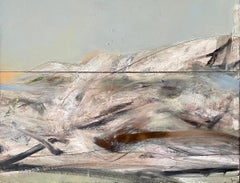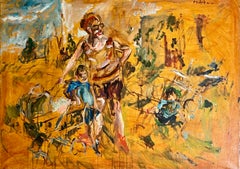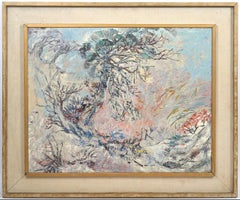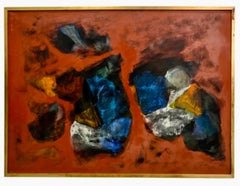Want more images or videos?
Request additional images or videos from the seller
1 of 10
Bruce SamuelsonAmerican Modernist Abstract Oil Painting Landscape Seascape1984
1984
$1,800List Price
About the Item
About the Seller
4.9
Platinum Seller
Premium sellers with a 4.7+ rating and 24-hour response times
Established in 1995
1stDibs seller since 2014
1,810 sales on 1stDibs
Typical response time: 1 hour
Authenticity Guarantee
In the unlikely event there’s an issue with an item’s authenticity, contact us within 1 year for a full refund. DetailsMoney-Back Guarantee
If your item is not as described, is damaged in transit, or does not arrive, contact us within 7 days for a full refund. Details24-Hour Cancellation
You have a 24-hour grace period in which to reconsider your purchase, with no questions asked.Vetted Professional Sellers
Our world-class sellers must adhere to strict standards for service and quality, maintaining the integrity of our listings.Price-Match Guarantee
If you find that a seller listed the same item for a lower price elsewhere, we’ll match it.Trusted Global Delivery
Our best-in-class carrier network provides specialized shipping options worldwide, including custom delivery.You May Also Like
Landscape with Orange Sky
Located in Wilton Manors, FL
James Earl Ray (1928-1998). Landscape with Orange Sky. ca. 1975. Oil on masonite panel measures 6.5 x 8.5 inches, 10.5 x 12.5 inches framed. Signed lowe...
Category
Mid-20th Century Abstract Abstract Paintings
Materials
Masonite, Oil
'Abstract Landscape', by Katherine Westphal, Oil on Board
Located in Oklahoma City, OK
Katherine Westphal's oil on board painting titled 'Abstract Landscape' embodies the stylistic qualities of abstract painting. Using a diverse color palette of orange, red, yellow, bl...
Category
Mid-20th Century Abstract Landscape Paintings
Materials
Masonite, Oil
$1,840 Sale Price
20% Off
H 24.25 in W 30.25 in D 0.875 in
Harbor abstract in Deep Blues
By Donald Roy Purdy
Located in New York, NY
Signed lower left: Purdy
A very cool example of mid-century 50"s abstraction. Harbor is done in a style that was being experimented with particularly in the New York and California ...
Category
Mid-20th Century Abstract Landscape Paintings
Materials
Oil, Masonite
A Summer's Sunset
Located in San Francisco, CA
In this abstract landscape, artist Geneva Cross conveys the mood of a dreamlike summer evening that might be remembered by any of us in its universality. Blending the basic elements ...
Category
1970s Abstract Abstract Paintings
Materials
Masonite, Oil
Landscape 128 by Jean Krille - Oil on masonite 70x50.5 cm
By Jean Krille
Located in Geneva, CH
Jean Krillé’s paintings are known for their expressive use of color and dynamic, abstract forms, blending realism with abstraction in his depictions of nature. His landscapes often f...
Category
Late 20th Century Abstract Landscape Paintings
Materials
Masonite, Oil
$1,900
H 27.56 in W 19.89 in D 0.4 in
"Crossed Arms" Mid Century Abstract Expressionist NYC Female Artist
By Sylvia Rutkoff
Located in Arp, TX
Sylvia Rutkoff (1919-2011)
Sr5-1
c.1960s
“Crossed Arms”
Acrylic on Masonite
36x42 period frame
Unsigned
Collection acquired from family estate
Category
Mid-20th Century Abstract Expressionist Landscape Paintings
Materials
Masonite, Oil
$4,000
H 36 in W 42 in D 2 in
"The Cowboy" Mid Century Abstract Expressionist Female Artist
By Sylvia Rutkoff
Located in Arp, TX
Sylvia Rutkoff (1919-2011)
Sr11-1
c.1960s
“The Cowboy”
Oil impasto on Masonite
42x36 period frame
Signed on reverse in pencil
Collection acquired from family estate
Category
Mid-20th Century Abstract Expressionist Landscape Paintings
Materials
Oil, Masonite
$6,000
H 36 in W 42 in D 1 in
Abstract Landscape, Oil on Masonite by Female Artist Miriam Bromberg
By Miriam Bromberg
Located in Long Island City, NY
Abstract Landscape
Miriam Bromberg
Date: circa 1960
Oil on Masonite
Size: 7.5 x 9.25 in. (19.05 x 23.5 cm)
Frame Size: 13 x 15 inches
Category
1960s Abstract Abstract Paintings
Materials
Masonite, Oil
Boxstrip Monument
By Kim Frohsin
Located in Burlingame, CA
Abstract expressionist landscape created with jewel tones portraying architectural elements is this early and important mixed media: acrylic, dry pigment, ink, pencil on archival boa...
Category
Late 20th Century Abstract Geometric Landscape Paintings
Materials
Masonite, Oil, Acrylic
Cyan & Orange Seascape at Sunset by Victor Papkov
Located in Soquel, CA
Expressive and colorful seascape by Vasil (Victor) Papkov (20th Century). The vivid cyan blue churning waves mirror the sky above, with a glowing orange sunset splitting the canvas o...
Category
1980s Abstract Impressionist Landscape Paintings
Materials
Masonite, Oil
$1,500
H 14.25 in W 18.25 in D 1 in
More From This Seller
View AllAmerican Modernist Abstract Oil Painting Landscape Seascape
By Bruce Samuelson
Located in Surfside, FL
framed 14.5 x 17. image 9.5 x 12
Signed verso
Bruce Samuelson was born in Philadelphia and was educated at PAFA. He has taught painting and drawing at PAFA since 1973.
Professor B...
Category
1980s Abstract Abstract Paintings
Materials
Masonite, Oil
Large Abstract Beach Scene Oil Painting Woman with Children Raoul Middleman
By Raoul Middleman
Located in Surfside, FL
Large Orange Oil on Canvas Painting by Raoul Middleman
Beach scene, family at the shore.
38 X 52.5 inches
Raoul Middleman (born 1935 in Baltimore, Maryland) is an American painter. Middleman has been a member of the Maryland Institute College of Art faculty since 1961. American University Museum at the Katzen Center has described Middleman as a "Baltimore maestro [whose] nudes are not pretty—they are sagging, dimpled, and real. His cityscapes reveal the underbelly of post-industrial rot, his narrative paintings give contemporary life to his personal obsessions. They are intelligent, messy, and utterly masterful."
From an interview with RM "I was doing abstract art. Then Roy Lichtenstein came around, and I wanted to be current. I remember Grace Hartigan said, “You’ve gotta go to New York, seize destiny by the hand.” My friend Jon Schueler took my slides up to Eleanor Ward, who had the Stable Gallery. My Pop art paintings were discovered. I moved to New York into Malcolm Morley’s old loft down on South Street. Agnes Martin was upstairs... People who interest me come from different quarters. I knew guys around Schueler, like B.H. Friedman. But I also knew the Pop world pretty well – Al Hansen, Richard Artschwager, Lichtenstein. I became friends with Raoul Hague...
Category
1970s Abstract Landscape Paintings
Materials
Oil, Canvas
Florida Oil Painting African American Woman Art Annie Nobles Miller Indian River
Located in Surfside, FL
"Annie Nobles Miller"
Abstract Florida landscape oil on board painting
Hand signed lower left Inscribed on verso St. Lucie County.
Measures: Board 24"H x 30"W; Framed - 32"H x 38"W.
Annie Miller was a member of the Indian River School of Painting, which was not a formal school but was a group of mostly African-American Florida working class people who wanted to paint. Following is the explanation of that school and its participants. Indian River School is a name applied to Floridian artists in the 1950's and 1960's. They were heavily influenced by nature. Most of the artists in this movement were African American. Their work is characterized by quick strokes and eschews traditional methods of paintings. The main influence for the group was a man named A.E. Backus, a Bohemian white man who mentored the group of young black artists. The group used to congregate in his studio and learnt to paint from 'Beanie' (as he was called) as a way out of their lower class labour jobs. Their work was powerful, dramatic yet captured the serenity and beauty of the Florida
Although the exact count of artists mentored by A.E. Backus remains unknown, experts estimate it to be around 20 individuals, many of whom he supported through college.
Albert Ernest "Beanie" Backus (1906–1990) was famous for his vivid, naturalist Florida landscapes capturing a fast-vanishing Florida wild lands. Backus would come to be seen as the seminal Florida landscape painter, and others who followed would emulate him. Primarily of the Indian River and Everglades areas of Florida. Backus was a Native Floridian artist of great importance recreating scenes of Florida's sky, rivers, ocean, back country, unpredictable weather, clouds, and birds. Born in Fort Pierce, FL to a family of talented boat designers and builders. His "Uncle" Reg Goodwin helped Backus as a young painter go to the Parsons School of Fine Art in New York in 1924. He was referred to as “Florida’s painter laureate,” and the “Dean of Florida’s landscape painters.”In addition to his influence on the Florida Highwaymen painters (Alfred Hair...
Category
1960s Abstract Abstract Paintings
Materials
Oil, Board
Large Polish French Abstract Expressionist Oil Painting Willy Mucha, Ecole Paris
By Willy Mucha
Located in Surfside, FL
French Large Abstract Expressionist Oil on Canvas Painting by Willy Mucha 1963
Frame: 39.5 X 52.5
Image: 38 X 51
Willy Mucha (1905 - 1995) was active/lived in France. Willy Mucha ...
Category
20th Century Abstract Abstract Paintings
Materials
Canvas, Oil
Nell Sinton Abstract Expressionist Landscape San Francisco California Modernist
Located in Surfside, FL
Eleanor Nell Sinton
Roots and Stems 1950,
Oil on canvas,
Signed lower right N. Sinton,
Provenance: Braunstein Quay Gallery (bears label verso)
Framed: 24.5 X 20.5 sight 21 X 17 i...
Category
1950s Abstract Expressionist Abstract Paintings
Materials
Canvas, Oil
Large Original Abstract Colorful Oil Painting Israeli Kibbutz Landscape Shemi
By Calman Shemi
Located in Surfside, FL
Life in Nature
Canvas measures 31.5 X 39.5
(I believe this is oil it might also be acrylic.)
Hand signed recto and signed and titled verso.
Calman Shemi, sculptor and painter, was ...
Category
1980s Abstract Geometric Abstract Paintings
Materials
Canvas, Oil
Recently Viewed
View AllMore Ways To Browse
Seascape Oil Painting Modernist
Pafa Artists
Tammy Staab
Taron Marukyan
Ted Collier
Ted Fuller
Terri Priest
Textured Mirrored Artwork
The Tropics By Dairo Vargas
Thomas Spoerndle
Thomas V Field
Three Phases Biomorphic Abstract Expressionist Painting
Tiffany Something Blue
Tj Bohm
Todd Garner
Toni Garau
Totem Pole Art Painting
Tran Hau Luu



